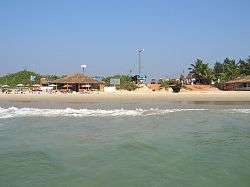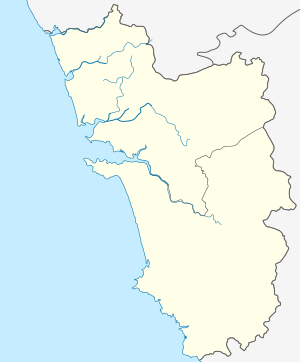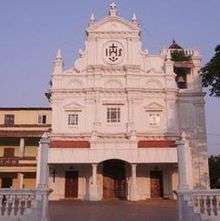Colva
Colvá is a coastal village in Salcete, south Goa, on the west coast of India. Colva Beach stretches for around 2.4 kilometres (1.5 mi), part of a beach consisting of about 25 kilometres (16 mi) of powder white sand, lined along its shore by coconut palms and extending from Bogmalo in the north to Cabo de Rama in the south.
Colvá Praia da Colvá | |
|---|---|
Village | |
 Colvá beach | |
| Nicknames: Saxttiche Yead, White Sand Beach | |
 Colvá Location of Colvá in Goa  Colvá Colvá (India) | |
| Coordinates: 15°16′34″N 73°55′02″E | |
| Country (1961 to Present) | |
| State | Goa |
| District | South Goa |
| Sub-district | Salcete |
| Past Country (1510 to 1961) | |
| Elevation | 1.1 m (3.6 ft) |
| Time zone | UTC+5:30 (IST) |
| Postcode | 403708 |
| Area code(s) | +91 832 |
Colvá is a famous tourist destination, visited for its beaches, budget hotels, guest houses, beach shacks, food stalls, restaurants, pubs and bars. The beaches are constantly monitored by lifeguards, and the swimming areas are flagged for warnings.
The village had significant importance to Portugal and was the retreat for Goa's high society, who would come to Colvá for their "Mundanca" or change of air. Today the Portuguese area is dotted with houses or villas, including many ruins. On weekends, huge crowds of tourists, visitors from around the world as well as local Indians, enjoy the sunset and various activities. The beach is particularly busy in October, when hordes of religious pilgrims come and visit Colvá Church, called Igreja de Nossa Senhora das Merces, that was founded in 1630 by the Roiz family and rebuilt in the eighteenth century on the village square.
The local people have been fishermen since the mid-16th century. They include Hindu converts as well as migrants from various Portuguese overseas territories such as Angola, Mozambique, Brazil, etc. as well as Portugal itself.
History
Colvá was a vast barren uninhabited land with a scenic Arabian Sea beach that had beach plants such as scaevola sericea until a few Harim (Fisherfolk community) settled there as migrants, primarily in the neighbouring village of Benaulim. The mughals, the people of Adil Shahi dynasty preferred the north and hilly regions of Goa, where they built forts and defences, rather than the coastal belt, and hence had not settled the barren land of Colvá. It was the Portuguese conquest which established the western regions of South Goa as a full-fledged human settlement.
Colvá was under Portuguese administration, as the Province of Portuguese-Goa, from 1510 until 1961 (and was still under dispute and represented in the Parliament of Portugal till 1974/75). It was the village of the Portuguese Roiz family, the descendants of D. Diogo Rodrigues, and its villagers. The village had belonged since 1550 to D. Diogo Rodrigues, who was the Lord of Colvá (Landlord of Colvá). He built the first Portuguese architecture residential house in 1551 facing away from the sea and at a distance from the shore to avoid any enemy attacks from the Arabian Sea. The entire beach called Praia da Colvá belonged to him.
In the 18th century, one of Diogo's descendants, Sebastião José Roiz, ordered the village people to plant coconut trees along the entire coastline, which the villagers thought was a waste of time as the soil was white and thus infertile and unable to sustain their growth. However today the shore line is fringed by those plantations of coconut trees. The entire Colvá shore and beach property as far as Betalbatim was inherited by various descendants of the Roiz family until the late 20th century, after which parts were handed over to the Government of Goa under the post-1974 Indian administration following the 1961 annexation of Goa by India. The rest of the land was sold.

Colvá is still famous for the white-washed Our Lady Of Mercy church, also known as Igreja de Nossa Senhora das Merces, that was founded in 1630 and rebuilt in the eighteenth century in the village square. It houses the miraculous statue of 'Menino Jesus' (Baby Jesus), which was introduced by a Jesuit missionary and which is believed to have healing powers. According to local legend, the statue at Our Lady of Mercy church was found in the mid-seventeenth century along the coast of Mozambique after Rev Fr. Bento Ferreira and his party had been shipwrecked off the coast. After swimming to safety, they spotted it as it was washed ashore after being dumped into the sea by Muslim pirates. In 1648 when Father Ferreira was posted to Colvá, he placed the statue on the altar, and it soon started drawing large crowds of devotees as it granted their favours. The Menino Jesus statue is kept for public viewing in October for the annual Fama ('Fame') festival for which thousands of people assemble. This is the only time that it is removed from the triple-vault locks of the Church. It is then dipped into a nearby river after a procession, and the pilgrims use this water for anointment and good luck.
Demographics and Geography
Location
Colvá has an average elevation of 1.1 metres (3.6 ft). Its main village market is located behind the church, which is about 2.3 km (1.4 mi) away from the beach; there are various other shops at the cross road near the beach. Colvá recognises three beaches; firstly the main Colvá beach which is the prime beach, secondly Sunset beach (towards Betalbatim) which is less congested, and thirdly Baywatch beach (towards Benaulim at Sernabatim). Colvá is 8 km (5.0 mi) from Margao and 40 km (25 mi) from Panajim. The closest railway station is in Margao followed by Vasco da Gama, Goa. The airport is Dabolim Airport (GOI) at Vasco da Gama, Goa. The neighbouring villages are Betalbatim and Benaulim and the nearest city Margao.
Distances around Goa (from Colva): Margao - 8 km (5.0 mi), Vasco - 35 km (22 mi), Mapusa - 53 km (33 mi), Calangute - 56 km (35 mi), Ponda - 28 km (17 mi), Dabolim Airport - 28 km (17 mi), Panjim - 40 km (25 mi), Tiracol - 82 km (51 mi).
Climate
Colvá features a tropical monsoon climate under the Köppen climate classification. Colvá, being in the tropical zone and near the Arabian Sea, has a hot and humid climate for most of the year. The month of May is the hottest, seeing day temperatures of over 35 °C (95 °F) coupled with high humidity. The monsoon rains arrive by early June and provide a much needed respite from the heat. Most of Colvá's annual rainfall is received through the monsoons which last till late September.
Colvá has a short winter season between mid-December and February. These months are marked by nights of around 21 °C (70 °F) and days of around 28 °C (82 °F), with moderate amounts of humidity.
| Climate data for Colvá | |||||||||||||
|---|---|---|---|---|---|---|---|---|---|---|---|---|---|
| Month | Jan | Feb | Mar | Apr | May | Jun | Jul | Aug | Sep | Oct | Nov | Dec | Year |
| Average high °C (°F) | 31.6 (88.9) |
31.5 (88.7) |
32.0 (89.6) |
33.0 (91.4) |
33.0 (91.4) |
30.3 (86.5) |
28.9 (84.0) |
28.8 (83.8) |
29.5 (85.1) |
31.6 (88.9) |
32.8 (91.0) |
32.4 (90.3) |
31.3 (88.3) |
| Daily mean °C (°F) | 25.6 (78.1) |
26.0 (78.8) |
27.6 (81.7) |
29.3 (84.7) |
29.7 (85.5) |
27.5 (81.5) |
26.5 (79.7) |
26.4 (79.5) |
26.7 (80.1) |
27.7 (81.9) |
27.6 (81.7) |
26.5 (79.7) |
27.3 (81.1) |
| Average low °C (°F) | 19.6 (67.3) |
20.5 (68.9) |
23.2 (73.8) |
25.6 (78.1) |
26.3 (79.3) |
24.7 (76.5) |
24.1 (75.4) |
24.0 (75.2) |
23.8 (74.8) |
23.8 (74.8) |
22.3 (72.1) |
20.6 (69.1) |
23.2 (73.8) |
| Average precipitation mm (inches) | 0.2 (0.01) |
0.1 (0.00) |
1.2 (0.05) |
11.8 (0.46) |
112.7 (4.44) |
868.2 (34.18) |
994.8 (39.17) |
512.7 (20.19) |
251.9 (9.92) |
124.8 (4.91) |
30.9 (1.22) |
16.7 (0.66) |
2,926 (115.2) |
| Average precipitation days | 0.0 | 0.0 | 0.1 | 0.8 | 4.2 | 21.9 | 27.2 | 13.3 | 13.5 | 6.2 | 2.5 | 0.4 | 90.1 |
| Mean monthly sunshine hours | 313.1 | 301.6 | 291.4 | 288.0 | 297.6 | 126.0 | 105.4 | 120.9 | 177.0 | 248.0 | 273.0 | 300.7 | 2,842.7 |
| Source: World Meteorological Organisation (UN) | |||||||||||||
Language
The Saxtti dialect of Konkani, belonging to the Indo-European family of languages, is the local language and spoken widely by the people of Colvá. Konkani, is primarily written in the Latin script in Colvá. Portuguese is spoken by the elite and older generations including the ones with Portuguese ancestry. English is spoken by all and is compulsorily taught in schools. Hindi is spoken by migrants after the Invasion of Goa and is spreading in all regions of Goa.
Colva Beach
| Colva Beach | |
|---|---|
| Geology | Beach |
Colva beach stretches for around 2.4 km, part of a beach consisting of about 25 km of powder white sand, lined along its shore by coconut palms, and extending as far as Bogmalo Beach to the north and Cabo de rama Beach to the South Goa's coastline.[1] Colva is now a famous tourist destination, enjoyed for its beach. The tourist industry is well developed with many budget hotels, guest houses, beach shacks, food stalls, small restaurants and pubs and bars, although these developments have not extended in any large degree to the nightlife. The beaches are constantly monitored by lifeguards and the swimming areas flagged with coloured flags accordingly. Being one of the famous beaches of Goa, this beach is highly crowded most of the time of the year. With a majority of its visitors being domestic Indian visitors this beach is mostly neglected by foreigners.[2]
Travel
The nearest airport is Dabolim Airport which is about 21 km away. The nearest railway station is Madgoan junction railway station in just 20 minutes drive. Colva beach can be reached from Margao by bus. Private transport such as cabs, auto rickshaws are also available.[3]
Culture
Religion
Colvá is predominantly Roman Catholic and has Hindus as well as Muslims who live there with peace and harmony. The recently constructed Mangueshi temple is the presence of a growing Hindu population in Colvá. The festivals of all religions are celebrated and enjoyed by all communities. The main village church has various masses and novenas at various times of the year. The traditions of 'saibin' or Mother of Jesus visiting each one's home is still continued. The traditional feast called 'Fama' is celebrated on the 2nd Monday of October every year, and pilgrims from around the world take part.
Food and beverages
Colvakars, or people from Colvá, love fish and seafood. The cuisine is influenced by Hindu Gaud Saraswat Brahmin origins and four hundred years of Portuguese governance and recently a blend of modern techniques. The locals enjoy rice with fish curry (xitt kodi in Konkani), which is the staple diet in Goa. Colvá cuisine is famous for its rich variety of fish dishes cooked with elaborate recipes. Coconut and coconut oil are widely used in cooking along with chili peppers, spices and vinegar, giving the food a unique flavour. Various seafood delicacies include kingfish (visvonn, the most common delicacy), pomfret, shark, tuna and mackerel. Among the shellfish are crabs, prawns, tiger prawns, lobster, squid and mussels. Colvá food has pork dishes such as vindaloo, chouriço and sorpotel. Beef dishes and chicken xacuti are cooked for major occasions amongst the Catholics. Sannas are relished. A rich egg-based, multi-layered sweet dish known as bebinca is a favourite at Christmas. Rissóis de camarão, beef croquettes, fried mussels and semolina prawns are favourite starters.
The most popular alcoholic beverage in Goa and enjoyed in Colvá is feni. Cashew feni is made from the fermentation of the fruit of the cashew tree, while coconut feni is made from the sap of toddy palms. The people also drink wine, especially on feast days.
References
- "Archived copy". Archived from the original on 25 November 2012. Retrieved 22 December 2012.CS1 maint: archived copy as title (link)
- http://www.goaholidayguide.com/beaches/colva-beach-goa.php
- "Archived copy". Archived from the original on 7 August 2016. Retrieved 2 August 2016.CS1 maint: archived copy as title (link)
External links
| Wikimedia Commons has media related to Colva. |
| Wikivoyage has a travel guide for Colva. |
- "GoaCentral.Com - Colva Beach"
- "Colva Fama" at GoaTourism.gov.in
- Colva Photographs, 2012